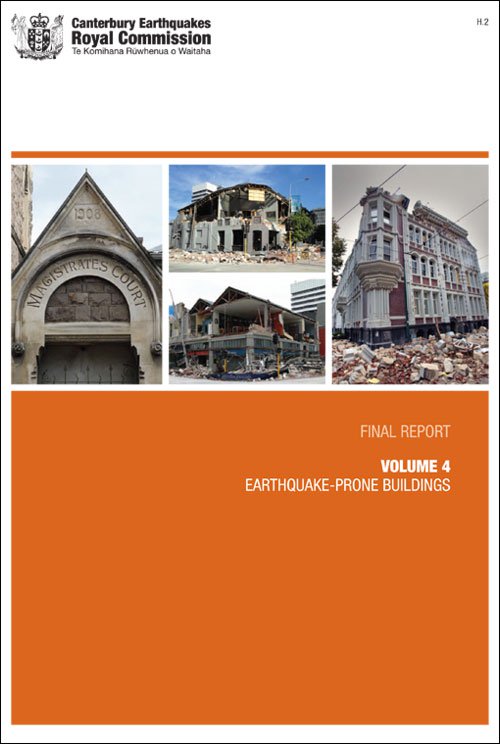Final Report - Part Two (Volume 4)
Part Two of the final report, consists of one volume (Volume 4) and contains recommendations about earthquake-prone buildings. It was delivered to the Governor-General on 10 October 2012 and released by the Government on 7 December 2012.

Part two consists of one volume - Volume 4: Earthquake-prone buildings (download documents below).
Section 1: Summary and Recommendations - Volume 4
View HTML version of the Summary and Recommendations - Volume 4
Download the Summary and Recommendations - Volume 4 (PDF version) 9 pages, 994kb
Download the Summary and Recommendations - Volume 4 (WORD version) 9 pages, 72kb
Volume 4: Earthquake-prone buildings (complete document)
Download a PDF version of the whole document or follow the links below for .docx versions of Volume Four, by section.
Download a PDF version of Volume 4 - complete document (4.7 MB)
Volume 4 - Word (.docx) versions
- Contents, letter of transmittal, introduction, Sections: 1, 2 and 3 (.docx) 683K
Letter of transmittal
Introduction
Section 1: Summary and recommendations – Volume 4
1.1 Free-standing masonry walls
1.2 Assessing existing buildings
1.3 Improving existing buildings
1.4 Earthquake-prone buildings policy and legislation
1.5 Adjacent and adjoining buildings
1.6 Buildings divided into separately owned parts
1.7 Altering an existing building
1.8 Inclusion of residential buildings
1.9 Impediments to the rebuild, repair or demolition of dangerous buildings – the Resource Management Act 1991 and the Historic Places Act 1993
1.10 Knowledge, information and education
Section 2: Design standards and legislative history
2.1 The evolution of seismic design standards in New Zealand
2.2 Overview of the development of the regulatory framework for dangerous and earthquake-prone buildings
Section 3: Building types in the Christchurch Central Business District
- Section 4: Individual unreinforced masonry buildings that caused fatalities (.docx) 4.1MB
4.1 Introduction
4.2 The CCC’s earthquake-prone buildings policies
4.3 Building fatalities
4.4 39 Bishop Street, St Albans
4.5 89, 91 and 93 Cashel Street
4.6 32 Cathedral Square
4.7 90 Coleridge Street
4.8 382 Colombo Street
4.9 593 Colombo Street
4.10 595 and 595A Colombo Street
4.11 601 and 601A Colombo Street
4.12 603 and 605–613 Colombo Street
4.13 617–625 Colombo Street
4.14 738 Colombo Street
4.15 753–759 Colombo Street
4.16 309 Durham Street North
4.17 194 Gloucester Street
4.18 194 Hereford Street
4.19 246 High Street
4.20 43 Lichfield Street
4.21 116 Lichfield Street
4.22 200–204 Manchester Street
4.23 265–271 Manchester Street
4.24 7 Riccarton Road
4.25 391 and 391A Worcester Street
- Section 5: Unreinforced masonry buildings and their performance in earthquakes (.docx) 196KB
5.1 Unreinforced masonry buildings and their characteristics
5.2 Earthquake performance
5.3 Observations on the behaviour of URM buildings
5.4 Some conclusions
- Section 6 and Section 7 (.docx) 336KB
Section 6: Assessing and improving the seismic performance of existing buildings
6.1 Introduction
6.2 Assessing the potential seismic performance of buildings
6.3 Techniques for and costs of retrofitting unreinforced masonry buildings
6.4 Improving non-URM buildings
6.5 Conclusions and recommendations – assessing and improving buildings
Section 7: Earthquake-prone buildings policy and legislation
7.1 Introduction
7.2 Policies about earthquake-prone buildings
7.3 The earthquake-prone threshold
7.4 Conclusions and recommendations
7.5 Drafting issues with the current legislation
7.6 Addressing the cost of strengthening existing buildings
7.7 Impediments to the rebuild, repair or demolition of dangerous buildings – the Resource Management Act 1991 and the Historic Places Act 1993
7.8 Knowledge
- Appendices (.docx) 193KB
Appendix 1: Seismic retrofit case studies
Appendix 2: Terms of Reference
Appendix 3: Expert advisers
Appendix 4: Submitters and witnesses
